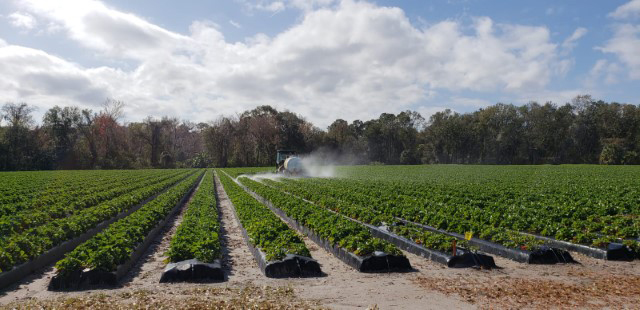An interview with Jason Garcia, Huma Gro® Regional Manager and Agronomist

In August, Florida strawberry growers will begin laying plastic for the next season. Planting starts in September/October and harvest extends from December to early April. After the strawberry season, growers are double-cropping with watermelon, bean crops, or vegetable crops.
In the following interview with Huma Gro® Regional Manager and Agronomist, Jason Garcia, we cover the Brilliance variety of strawberry and recommended nutrient applications.
What are the hot topics in strawberries in Hillsborough County?
New berry varieties. Berry varieties start out strong before they run their course. Most varieties have a 10 to 12-year life span before being replaced by the variety that’s coming out. There are a few challenges with new varieties. It generally takes a couple of seasons before we really understand how those varieties need to be treated in terms of planting dates and nutritional factors.
Are you ironing out those differences now?
We have them ironed out. We ran into a few issues the previous strawberry season because we treated them as we had our other varieties, planted a bit too late. Having been born and raised here, I’ve never seen all the fields planted by the end of September. So, we learned our lesson there about changing our planting date, backing it up a couple of weeks. The weather has a lot to do with it. Soil temperature has a lot to do with it. There are a lot of factors that figure into it. We want to hit the market as soon as we can because that’s where the growers are getting the better price.
Tell us about the locally-grown varieties.
Let me start with the varieties that have been around for a while. Sensation is a great berry. Radiance has also been around a bit. Then, there are our new varieties. Florida Beauty, in my opinion, is lacking in beauty. The Brilliance variety puts out a higher quality fruit than some of the other varieties.
About 90% of my growers have ordered their plants for next year. I don’t have a lot of growers who will be planting Radiance. They’re going to be replacing those with the Brilliance. It looks like the majority of the acres in Florida will be planted with the Sensations and the Brilliance.
What makes the Brilliance more appealing than the Radiance?
It’s an early picking or early market berry. We get what we call bullets. The berries are almost shaped like a bullet. This is due to high soil temperatures. The fruit isn’t given enough time to size-up and mature into a marketable berry. So, you’re throwing a lot of fruit on the ground. These Brilliance have shown that they aren’t as touchy as the Radiance. So, we’re getting good quality fruit on the early picks when the market’s high.
What different requirements are you seeing for the Brilliance?
As far as nutrients go, we’re going to keep using historical treatments. All our liquid nutrients go through a drip and everything’s under plastic. So, soil nutrients will be going through drip tape. They will continue to run the same way, adding in foliar applications of Huma Gro®. We have some programs this coming season that will increase not only early fruit size but also increase early fruit yield.
As far as the nutrition requirements difference between the two, in my opinion, the Brilliance doesn’t require as much nitrogen early on as we’re used to applying. That can cause the issues that we’re seeing, depending on weather events. When putting out too much nitrogen early on, and if we have a weather event, then that’s when strawberry diseases start up.
And by weather events, you mean rain, flooding?
Yes. Basically, just rain. If we’re dry, we have other issues with soil temperatures. In high soil temperatures, strawberry plants have a hard time establishing roots. But if we’re getting too much rain, that’s when your bacteria and your different diseases start in on the plant.
Does the Brilliance have a different planting schedule?
We’re going to tweak our planting dates with the Brilliance. Two seasons ago, the University of Florida told us we planted too late, that we needed to plant earlier. This past season, we had a much higher percentage of Brilliance in the ground than the Radiance. A lot of growers planted earlier and then we had high soil temperatures. By the time we put the plants in the ground, the soil temperatures reached about 112° at 2:00 in the afternoon. We were trying to use water to cool the soil temperatures, but we had to reset a lot of plants. So this year, we’re going to be backing our planting dates up a little bit.

Huma Gro Strawberries in Plant City, Florida
What Huma Gro® program do you recommend to Florida strawberry growers?
Before I was working with Huma Gro®, I was looking at a research trial that Barrett Smith set up. It was a soil fumigation trial replacing traditional fumigation with the Promax®. We had great results.
When it comes to a berry program, Promax® is a great product. Florida strawberry growers have issues with weeds during fumigation. Whether we’re applying conventional fumigation or Promax®, nutsedge will be coming up out of the plastic before we even get it done. There isn’t a good conventional fumigant that is also effective on weeds. We have to add an herbicide application on the plastic before the plants are put in the ground. When you’re adding the cost of an herbicide to the cost of conventional fumigation, it can get pricy. The benefit of using Promax® is that it’s less than half the cost of conventional fumigation per acre. It’s a no brainer. The grower is saving money right off the bat.
Once we set the plants, we’ll be going out with the Super Phos® to help establish the root system and get the plant into production. Also, at that point, we’ll start applying Zap®—rotating Promax® and Zap®—to rebuild the soil structure.
Do you recommend different application rates for different plants in different areas or do you recommend the same application rate across the board?
Sometimes I like to change up application rates, but most of these growers have multiple fields in many different areas of the county who rely on field workers to apply their crop products. So, we try to keep it simple to make it fool-proof.
What are the recommended application rates?
We went at a higher rate on the trial but with the Promax®, I recommend ½ to 1 gallon per acre per month and about ½ gallon per acre per month of Zap®. We have about a 7- to 10-day period where we water in, applying overhead water after planting. When we cut that overhead water off—when the plants are lived in—we like to run 2 quarts Super Phos® combined with 1 quart of Breakout® as a soil application through the drip to get those plants up and jumping. That’s a one-time application.
Which micronutrients do you recommend?
We use a lot of calcium after the plant is established. Depending on the grower, once the plants are established, we start putting out a quart of Vitol® and a pint of Breakout®. And once we start seeing berries, and the plants are utilizing a lot of calcium, we’ll add in a pint of Calcium. That’s done on a weekly basis. Once we get into full production, we back it down to a pint each of Vitol®, Breakout®, and Calcium. Depending on what our tissue tests are showing us, we’ll add a pint of Max-Pak® every other spray during the reproductive stage.
This coming season, we’re going to rotate the Golden Pro® and Vitol® together. There are several similarities between the two. But with Golden Pro®, we’ve seen that it increases the brix levels within the plant. So, if we all hit the market at the same time, and the coolers get full, our price per flat starts to drop. Some strawberry growers have a juicing or processing contract, which takes us into a totally different type of picking. The brix level has to be 6 or higher. By adding Golden Pro® in January—which is when we have our heavy pick—we can keep the Brix level as high as possible for strawberry farmers who have juicing or processing contracts.
What pests do you experience in the Hillsborough County area?
Nematodes are a big issue, and the Promax® takes care of that. Spider mites are another problem. Some insecticides are over $100 per acre but we have to apply them or we’re not going to have a crop. I recommend Proud 3®. Proud 3® works well with juveniles and soft-bodied insects, so we’ll be also putting out predatory mites. The thing with predatory mites is that you have to be careful with oil-based products until their population builds up because they’ll smother and kill them. And that’ll reduce your population of beneficial insects. So Proud 3®—since it has a thyme oil base—will be added around January, when the predatory mite population is well-established.
Jason Garcia was born and raised in Plant City where he grew up on a farm before he became involved in the technical aspects of farming. An agronomist and Huma Gro® Regional Manager, Jason has 25 plus years working with strawberry crops. Jason is located in Plant City, winter strawberry capital of the world. Approximately 12,000 acres of strawberries—which is most of the state’s berries—are grown in the Plant City/Hillsborough County area.
Huma Gro® products with Micro Carbon Technology® rapidly deliver essential nutrition to crops for optimal growth, fruiting, and vigor. The results are higher quality harvests, increased crop yields, and maximum profit.
Read more about growing strawberries:
Our white paper discusses sustainable alternatives to harmful soil fumigation.
- Improve soil health and fertility with a vigorous soil biology.
- Reduce dependency on fumigants.
- Increase your marketable yields
Related Posts

BHN Hires Dr. Mojtaba Zaifnejad to Oversee Agricultural Research
Bio Huma Netics, Inc. (BHN), has hired Mojtaba Zaifnejad, PhD, to be Senior Director of Field Research and Technical Services. In this position he will oversee the company’s agricultural product-use research and field trials for its Huma Gro® and Fertilgold® Organics soil health, crop nutrition, and crop protection brand lines. He will also provide technical

The Value of Humic Substances in the Carbon Lifecycle of Crops:
Humic Acids, Fulvic Acids, and Beyond. A New White Paper from Huma Gro® This white paper is based on an article by Huma Gro® staff originally published in the January 2017 issue of AgroPages Magazine. Humic substances play an important role in soil fertility and crop yield. This article provides a basic overview of what

Huma Gro® Stories From the Field—SE United States, No.1
In this first installment of Huma Gro® Stories From the Field, we feature 16 short stories from Florida and Georgia of growers’ use of 12 different Huma Gro® products on a variety of crops. The stories describe everything from increased yields to reduced nematodes, to recovery from frost damage to reduced effects from citrus greening.

